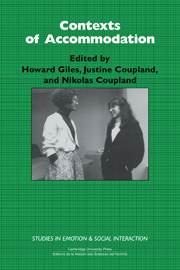Book contents
- Frontmatter
- Contents
- List of contributors
- 1 Accommodation theory: Communication, context, and consequence
- 2 Audience accommodation in the mass media
- 3 Accommodation on trial: Processes of communicative accommodation in courtroom interaction
- 4 Accommodation in medical consultations
- 5 Accommodation and mental disability
- 6 Accommodation in therapy
- 7 Accommodation in native-nonnative interactions: Going beyond the “what” to the “why” in second-language research
- 8 Interethnic accommodation: The role of norms
- 9 Organizational communication and accommodation: Toward some conceptual and empirical links
- Index
9 - Organizational communication and accommodation: Toward some conceptual and empirical links
Published online by Cambridge University Press: 18 March 2010
- Frontmatter
- Contents
- List of contributors
- 1 Accommodation theory: Communication, context, and consequence
- 2 Audience accommodation in the mass media
- 3 Accommodation on trial: Processes of communicative accommodation in courtroom interaction
- 4 Accommodation in medical consultations
- 5 Accommodation and mental disability
- 6 Accommodation in therapy
- 7 Accommodation in native-nonnative interactions: Going beyond the “what” to the “why” in second-language research
- 8 Interethnic accommodation: The role of norms
- 9 Organizational communication and accommodation: Toward some conceptual and empirical links
- Index
Summary
Introduction
Since its articulation in the early 1970s, speech accommodation theory (SAT) has evolved into a complex and rich conceptual framework that helps account for a broad range of communicative behaviors in both laboratory and field settings (Giles et al. 1987). During the 1980s, the accommodation framework was successfully adapted as a conceptual tool to better understand communicative processes in an ever-increasing range of applied settings, as indeed this volume attests. One aim of this chapter is to extend the accommodation framework to yet another applied setting: the rapidly developing field of organizational communication (Goldhaber and Barnett 1988; Jablin et al. 1987). Given the expanding scope of both the accommodation and organizational communication literatures, this first attempt to link these two fields of research is necessarily quite focused and selective. It is hoped that linking the accommodaton with the organizational communication field will provide the needed impetus for researchers in both these fields to join forces in addressing ever more pressing communication problems within organizations throughout the world.
The first section of this chapter provides a brief overview of the accommodation framework especially in relation to language switching in bilingual environments such as those found in Canada. The reason for this focus on accommodation research conducted in the Canadian setting is twofold. First, the earliest empirical studies supporting key features of the accommodation framework were conducted in the bilingual setting of Montreal, where instances of linguistic convergence and maintenance could be unequivocably monitored through clear-cut French- English language switches (e.g., Giles, Taylor, and Bourhis 1973).
- Type
- Chapter
- Information
- Contexts of AccommodationDevelopments in Applied Sociolinguistics, pp. 270 - 304Publisher: Cambridge University PressPrint publication year: 1991
- 10
- Cited by



